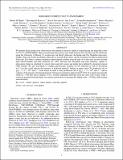MAIN-BELT COMET P/2012 T1 (PANSTARRS)
Author(s)
Hsieh, Henry H.; Kaluna, Heather M.; Novaković, Bojan; Yang, Bin; Haghighipour, Nader; Micheli, Marco; Denneau, Larry; Fitzsimmons, Alan; Jedicke, Robert; Kleyna, Jan; Vereš, Peter; Wainscoat, Richard J.; Ansdell, Megan; Elliott, Garrett T.; Keane, Jacqueline V.; Meech, Karen J.; Moskovitz, Nicholas; Riesen, Timm E.; Sheppard, Scott S.; Sonnett, Sarah; Tholen, David J.; Urban, Laurie; Kaiser, Nick; Chambers, K. C.; Burgett, William S.; Magnier, Eugene A.; Morgan, Jeffrey S.; Price, Paul A.; ... Show more Show less
DownloadHsieh-2013-Main-belt comet P_20.pdf (952.2Kb)
PUBLISHER_POLICY
Publisher Policy
Article is made available in accordance with the publisher's policy and may be subject to US copyright law. Please refer to the publisher's site for terms of use.
Terms of use
Metadata
Show full item recordAbstract
We present initial results from observations and numerical analyses aimed at characterizing the main-belt comet P/2012 T1 (PANSTARRS). Optical monitoring observations were made between 2012 October and 2013 February using the University of Hawaii 2.2 m telescope, the Keck I telescope, the Baade and Clay Magellan telescopes, Faulkes Telescope South, the Perkins Telescope at Lowell Observatory, and the Southern Astrophysical Research Telescope. The object's intrinsic brightness approximately doubles from the time of its discovery in early October until mid-November and then decreases by ~60% between late December and early February, similar to photometric behavior exhibited by several other main-belt comets and unlike that exhibited by disrupted asteroid (596) Scheila. We also used Keck to conduct spectroscopic searches for CN emission as well as absorption at 0.7 μm that could indicate the presence of hydrated minerals, finding an upper limit CN production rate of Q[suscript CN] < 1.5 × 10[superscript 23] mol s[superscript –1], from which we infer a water production rate of Q[subscript H2O] < 5 x 10[superscript 25] mol s[superscript –1], and no evidence of the presence of hydrated minerals. Numerical simulations indicate that P/2012 T1 is largely dynamically stable for >100 Myr and is unlikely to be a recently implanted interloper from the outer solar system, while a search for potential asteroid family associations reveals that it is dynamically linked to the ~155 Myr old Lixiaohua asteroid family.
Date issued
2013-07Department
Massachusetts Institute of Technology. Department of Earth, Atmospheric, and Planetary SciencesJournal
Astrophysical Journal
Publisher
Institute of Physics/American Astronomical Society
Citation
Hsieh, Henry H., Heather M. Kaluna, Bojan Novaković, Bin Yang, Nader Haghighipour, Marco Micheli, Larry Denneau, et al. “MAIN-BELT COMET P/2012 T1 (PANSTARRS).” The Astrophysical Journal 771, no. 1 (June 11, 2013): L1. © 2013 American Astronomical Society.
Version: Final published version
ISSN
2041-8205
2041-8213